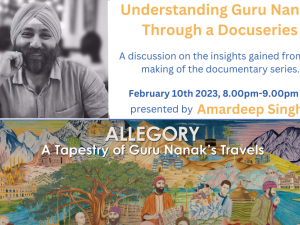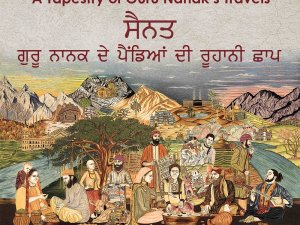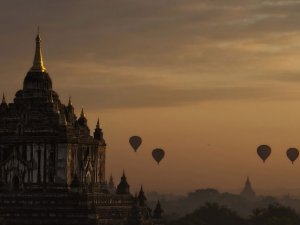This article 'Operation Bluestar - Let's Not ForgetOperation Bluestar - Let's Not Forget', written by Amardeep Singh, was originally published on June 6th 2014. This is an artistic and sober reminder of those dark days with a hope that it gives strength for a brither future. We are grateful to republish this article in honor of SikhNet 25th anniversary. Register to attend SikhNet's 25th Anniversary Virtual Gala.
That alone is a temple,
where He can be known.
Through contemplation in human body,
one understands His omnipresence.
Don’t look for him outside,
He dwells within the Heart.
The ego-willed cannot appreciate this fact,
in mere worldly pursuits he wastes his life.
He pervades everywhere,
discover Him through reflection.
– Guru Nanak (Ang 953, Adi Granth)
When an institution exists for its value then it’s bricks are not cemented in mortar but in the belief of it’s ideals.
In the name of Operation Bluestar, from 3 – 8 June 1984, the Indian army, under orders of Indira Gandhi, besieged the Golden Temple at Amritsar. For the first time in the history of India, the army was tasked to attack it’s own civilians, on a day when thousands of devotees throng to the temple to celebrate Guru Arjan Dev’s (5th Guru of the Sikhs) martyrdom day. The reason for attack was to remove Jarnail Singh Bhindranwale and his 150 followers who had taken shelter in the complex.
The background leading to this event is too complicated to cover in full as it runs from the time of partition of India in 1947, culminating into a political debacle of 1984. The basic issues spanned across:
-
Linguistic division of Indian state territories -
River water policy across the Indian states
-
Reduction of Punjabi’s in Defense force
-
Restriction of Government industrial investments in Punjab
Indian politics thrives on divisional themes. Imposition of national emergency by Indira Gandhi from the years 1975 – 1977 in order to retain her power at the centre of Indian politics became the catalyst to her communal based politics that emerged when she regained central power in 1980. In emergency period, Punjab was the only state in India to have openly opposed the national emergency rule imposed by Indira Gandhi, resulting in citizens courting peaceful arrest to demand national freedom under the democratic constitution of India. It is estimated that more than 140,000 people in Punjab offered themselves to be jailed. When she regained central power in 1980, it was her target to leverage communal based policies to break the Punjabi opposition that had voiced so openly against her emergency rule.
To break the voice in Punjab politics, that continued to be a strong force against Indira Gandhi’s governance style, she started implementing the divide and rule, religion based politics. The period thereafter witnessed the downward spiral in Punjab, resulting in the dark phase of the 1980s that my generation witnessed.
It is in this period that Jarnail Singh Bhindranwale emerged on the centre stage of Punjab.
The sequence of events moved rapidly out of control. By end 1983, Jarnail Singh Bhindranwale had moved himself inside the surrounding guest house area of the Golden Temple. Under the national law, when a civilian has to be arrested, it is the police and not the army that has to conduct the job. It is interesting to note that earlier he was once arrested by the police but released in less than 24 hours. So it is worth pondering why Indira chose not to use the civilian defense force but ordered the army to conduct the operation at Golden Temple on a day when innocent pilgrims would be thronging the complex. Her orders to use full military force to finish everyone inside the complex was essentially driven by her divisional political agenda as it’s through this action she would be able to further strengthen her position across India.
The destruction of Golden Temple compound was beyond comprehension. Tanks bombarded the Akal Takth. Over 8,000 people (Citizens of Democracy estimate the number at 8,000 but the Government records are at 493) are estimated to have been killed in the attack on Golden Temple, majority being innocent pilgrims. In my visit to Golden Temple in the following months, I saw the structure of Akal Takth in rubble. The central Golden Temple building had bullet marks all around it. Many years later, in the year 2000, the Defense Minister of India, George Fernandez acknowledged that the Indian Army in the 1984 operation had removed rare historical manuscripts and artefact, which no one knows where they have disappeared. In the events following the June 1984 attack on Golden Temple complex, two Sikh bodyguards of Indira Gandhi, assassinated her on 31st October, 1984. Within hours, emergency was imposed in Punjab so that no backlash happens in the state but interestingly across the rest of India, the new leadership of Indira Gandhi’s Congress party executed a pogrom (planned attack against the Sikh community), killing more than 8,000 Sikhs across the country, of which 3,000 were killed in broad daylight in Delhi.
An average Indian lacks the ability to see through divisional politics and Indira succeeded well in her game to divide and rule. If Punjab problem really existed as was blown out of proportion by Indra Gandhi’s divisional political aims, then it is worth asking, where is the problem today? It goes to show the self centered sinister plan of the Indian leadership in this phase of dark history.
What Indira Gandhi may not have known is that Golden Temple, has been a centre stage for the Sikh community. It has been attacked many times before and every time the community has responded against the brutal use of force but it has also been forgiving to move on very quickly. Between 1737 and 1767, Golden Temple was attacked six times by non Indian origin people, essentially the Mughal and Afghan forces. However, in 1984 it was the Indian Army that attacked it’s own citizens under the myopic divisive leadership of Indira Gandhi.
Three decades have passed and the Sikhs have moved on just like they moved on earlier in the history. However it is unfortunate that there has been no closure to the events. The missing artefacts and manuscripts have not been returned. The organizers of the 1984 anti Sikh pogrom conducted across India, after Indira Gandhi’s death, remain free. Justice has been denied to the citizens of India.
On the third decade of this tragic event, I share a few pictures of the Golden Temple and it’s complex that I made during my visit in 2010.
I also encourage you to visit the hyperlinks below of the previous photo series on Golden Temple.
Finally, in link below is a heartfelt poetry by my close friend, Ajay Shukla, on the anti Sikh pogrom conducted in November 1984.
In ending, I would like to reflect on the above verse by Guru Nanak (page 953 of Adi Granth) where he reminds us that the true temple is our human body, where “He” has to be found. Golden Temple is however the external manifestation of the intrinsic belief system of the Sikhs. So deep is the Sikh psyche associated with this institution that post the attack on the complex, when Indira Gandhi got the Akal Takth rebuilt by the Government money, the Sikhs made it a point to not accept her gesture. At the first opportunity, they raised it to the ground and rebuilt it from the community money.
May the future generations continue to reflect and talk about history as means of increasing love across communities and build on the ideals of value.
Golden Temple Comlex
Golden Temple
Golden TempleBungas from Parikrama
Golden Temple
Golden Temple
Golden Temple
Motif on floor of Golden Temple
Golden Temple
Golden Temple
A view from Akal Takth
Bungas at Golden Temple
Bunga at Golden Temple
Parikrama at Golden Temple
Entrance to Golden Temple
Bungas at Golden Temple
Golden Temple
Golden Temple in night
Akal Takth
View from Akal Takth
Entrance to Golden Temple
Window in Golden Temple
Pigeons at Golden Temple





